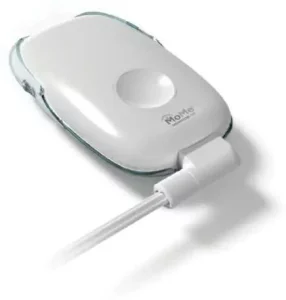

MoMe® Kardia System Patient Guide
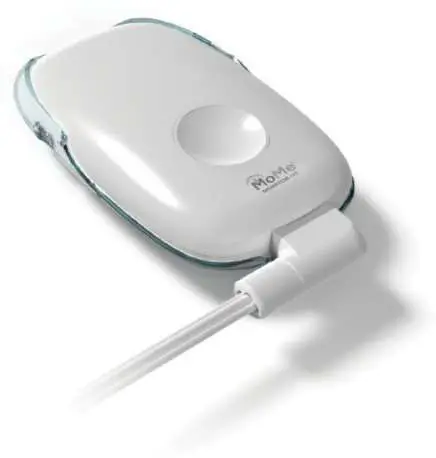
InfoBionic’s MoMe® Kardia System may be covered under one or more the United States and International Patents. Please see the website: www.infobionic.com to satisfy the virtual patent marketing provisions including America Invents Act and 35 U.S.C. § 287(a). Additional patents may be issued or pending in the US and elsewhere.
MoMe® Kardia System Components
MoMe® Kardia Kit Components
| No. | Component | Description |
| 1 | Monitor | A small, lightweight battery-operated device that collects, stores, and transmits physiological data to the remote server via a built-in cellular module |
| 1 | Lead Set | Attaches to the MoMe® Kardia monitor and to each electrode |
| 1 | Belt Clip | Used to carry the MoMe® Kardia monitor on your belt or waistband during the day |
| 2 | Rechargeable Battery Pack | Battery packs to power the MoMe® Kardia monitor. A fully charged battery will last for 24 hours and must be replaced with a charged battery each day to ensure uninterrupted monitoring |
| 1 | Charger Dock | Used to charge the battery packs |
| 1 | Charger Dock Power Cord | Used to connect the charger dock to AC wall socket |
| – | Electrodes | The lead set snaps to the electrodes. Electrodes will be provided by your physician |
Inspect all parts before use to ensure nothing is damaged and/or missing.
Unpacking MoMe® Kardia Device
- Unpack the MoMe® Kardia Kit and locate components listed in the Kit Components chart above.
- Plugin the charger dock and place one of the two included battery packs in the charger.
- Insert the second battery pack into the back of the Monitor (for more detailed instructions, see diagram on page 10). The device should turn on.
- Attach the lead set to the monitor.
- Place electrodes as indicated on page 6.
You are now monitoring.
Monitoring
Once the monitor is activated and operating, the system requires no intervention to capture or analyze data. However, your physician should instruct you about the following responsibilities:
- Charge the battery pack every day
- Report any symptomatic events by pressing the event record button as instructed by your physician
- Return the system to the practice at the end of the monitoring

Device Controls
The MoMe® Kardia monitor has three buttons:
Event Record, Wake, and Volume.

Wake: Press the wake button at any time to display the current battery level status.
Volume: Press the volume button to adjust the volume or silence alerts on the monitor. To adjust the volume, press up or down on the volume button. The display will be updated with the current level and a tone will be played at the current volume for audible feedback of the volume level. The lowest volume setting mutes the speaker and can be used when the patient’s sleep should not be disturbed. Pressing the volume button one more time after the lowest volume setting sets the monitor to vibrate mode.

Event Record: Press the event record button located on the face of the device to report a symptomatic event. The screen will display a solid heart when the event has been recorded.
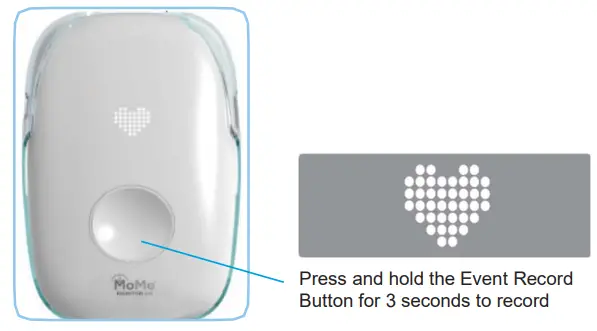
Notifications
Low Battery: When the battery level is low, the device will play an audio alert and will display the BATT LOW notification shown below.
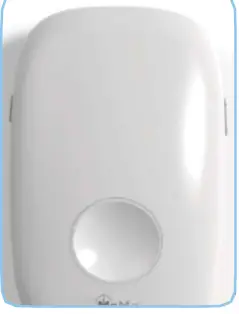

When the battery level is low the screen will display BATT LOW
Belt Clip
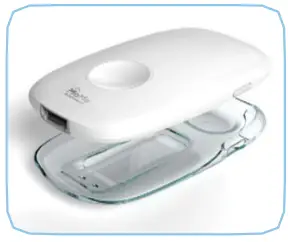
The MoMe® Kardia Monitor must be used with the included belt clip. Slide the monitor up and into the belt clip holster to secure the monitor in place then slide the clip over your belt or waistband with the lead set attachment facing upwards.
Charging Battery Pack
To charge the Battery Pack:
- Slide the battery pack into the charger dock until the charging indicator turns red and the battery pack stops.
- The battery pack is fully charged – when the indicator light turns green.
Note: Each battery pack takes approximately 3 hours to fully charge.

Installing Battery Pack
To install the Battery Pack, follow these steps:
- Place the battery pack into the monitor, pushing down until it is fully seated.
- Slide the battery pack towards the slide lever lock.
- The battery is installed when you hear the slide lever lock “click”.

Removing Battery Pack
To remove the Battery Pack, follow these steps:
- Push the slide lever lock to the right and hold.
- Push the battery pack away from the slide lever lock and release the slide lever lock.
- Lift the battery pack up and remove it from the monitor.
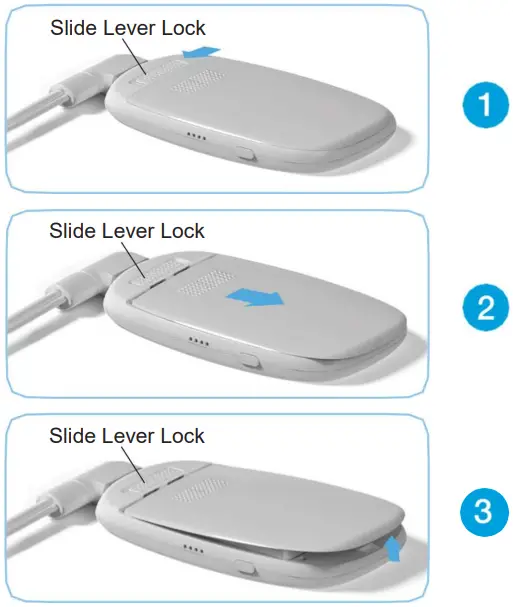
Warnings
- Warning: MoMe®Kardia is not intended for use on infants weighing less than 10kg (22 lb).
- Warning: Use only specified MoMe® Kardia cables and accessories. Use of any other cables and accessories may negatively affect EMC performance resulting in increased emissions and decreased immunity.
- Warning: Use only specified MoMe® Kardia accessories. Use of any other accessories may result in non-compliance.
- Warning: To avoid possible strangulation, route all cables away from the patient’s throat.
- Warning: The MoMe® Kardia Device is not defibrillation-proof. Remove MoMe® Kardia Device and disconnect patient leads before external defibrillation.
- Warning: Do not service or repair any components of the MoMe® Kardia Removal or tampering of the lead wires or any other component may alter device performance and cause device malfunction or failure. Contact your physician’s office for product repair or replacement.
- Warning: The MoMe®Kardia system may be affected by equipment even if the equipment is CISPR compliant.
- Warning: The MoMe®Kardia system should not be used in the presence of flammable anesthetics.
- Warning: The MoMe®Kardia contains a cellphone. If the patient has an implantable device, they should be instructed to follow their implantable device manufacturer’s recommendations for use with a cellphone.
- Warning: Never attempt to repair or service any MoMe® Kardia equipment. Repairs by untrained, unauthorized individuals may damage the equipment or cause system malfunction.
- Warning: The MoMe®Kardia is not intended to be used in an Oxygen-rich environment.
- Warning: Electrodes may cause skin irritation or breakdown. We recommend that standard FDA-approved Ag/AgCL ambulatory monitoring electrode patches be used and that the patient be instructed on what to do if skin irritation occurs.
- Keep the system out of reach of children and pets
Cautions
- MoMe® Kardia uses cellular phone technology, so the system operation and data transmission may be affected or interrupted by poor cellular coverage or electromagnetic interference. If data transmission is interrupted, MoMe®Kardia will automatically cache the data until cellular coverage or communication between the two devices is restored and then send the stored data.
- Use only MoMe®Kardia parts and accessories with the MoMe®Kardia system. Using non-MoMe®Kardia equipment may result in system malfunction or failure.
- Use only with the supplied battery packs, charger dock, and power cord.
- Prior to setting up a new patient with MoMe® Kardia, carefully inspect all system components for defects or damage. Check lead wires for cracks or fraying in the wiring, and cracks around the connector and snap leads. Do not use the MoMe®Kardia system if any component appears defective, damaged, or worn (e.g. cracks, dents, chips, cuts, kinks, or crushed or elongated sections), as this may result in system malfunction or failure. Contact your physician’s office for a replacement, if needed.
- MoMe® Kardia is not waterproof:
• Protect all MoMe®Kardia parts from water, liquids, or moisture which will damage equipment and affect system operation;
• Do not immerse any part of the MoMe® Kardia system in water or fluids. Do not spray device with cleaners or other liquids;
• Never bathe, shower, or swim while wearing the MoMe®Kardia Device (while bathing or swimming, store MoMeKardia equipment in a safe, dry location) - Do not drop or subject MoMe®Kardia parts to extreme physical shock.
- The MoMe® Kardia system uses and generates radiofrequency energy, so it may cause harmful interference to radio communication if not used according to instructions.
- The user should take precautions regarding electromagnetic compatibility, the MoMe® Kardia system needs to be used according to the EMC information provided in this IFU.
- The MoMe®Kardia provided for use in the U.S. will not transmit recorded data if the patient travels outside of the U.S.
- Do not use the MoMe®Kardia system in conditions that are:
• Below 32°F (0°C) or above 104°F (40°C);
• Less than 15% or greater than 93% non-condensing atmospheric humidity. - Do not store or transport MoMe®Kardia in conditions that are:
• Below -25°C or above 70°C;
• Less than 15% or greater than 93% non-condensing atmospheric humidity.
Battery Information
- Do not dismantle, open or shred secondary cells or batteries.
- Do not expose cells or batteries to heat or fire. Avoid storage in direct sunlight.
- Do not short-circuit a cell or a battery. Do not store cells or batteries haphazardly in a box or drawer where they may short-circuit each other or be short-circuited by other metal objects.
- Do not remove a cell or battery from its original packaging until required for use.
- Do not subject cells or batteries to mechanical shock.
- In the event of a cell leaking, do not allow the liquid to come in contact with the skin or eyes. If contact has been made, wash the affected area with copious amounts of water and seek medical advice.
- Do not use any charger other than that specifically provided for use with the equipment.
- Observe the plus (+) and minus (-) marks on the cell, battery, and equipment and ensure correct use.
- Do not use any cell or battery which is not designed for use with the equipment.
- Battery usage by children should be supervised.
- Keep cells and batteries clean and dry.
- Wipe the cell or battery terminals with a clean dry cloth if they become dirty.
- Secondary cells and batteries need to be charged before use. Always use the correct charger and refer to the manufacturer’s instructions or equipment manual for proper charging instructions.
- Do not leave a battery on prolonged charge when not in use.
- After extended periods of storage, it may be necessary to charge and discharge the cells or batteries several times to obtain maximum performance.
- Retain the original product literature for future reference.
- Use only the cell or battery in the application for which it was intended.
- Dispose of properly.
System Specifications
| MoMe® Kardia Monitor Specification (Model 01854 Rev B) | |
| Specification | MoMe® Kardia Monitor |
| Battery Life | Provides 24 hours of function before recharging |
| Operating Temperature | 5°C to 40°C |
| Storage Temperature (power off) | -25°C to 70°C |
| Operating Humidity | 15% to 93% non-condensing |
| Storage Humidity | 15% to 93% non-condensing |
| Operating Pressure | 700 hPa to 1060 hPa |
| ECG Sampling Rate Digital Resolution Input Dynamic Range Input Offset Dynamic Range |
200 Hz 5uV +/- 10 mV +/- 300 mV |
| Input Impedance | > 3 MOhm |
| Peak Current Injection | 24 nA (Leadoff circuit) DC |
| RMS Current Injection | 29 microA |
| Data Storage Capacity | Minimum 30 days |
| Dimensions | 108 mm x 67 mm x 17 mm max |
| Weight | 80 +/- 5 g |
| Communication Means | LTE, WCDMA Bands 2,4,5,12,13 |
| Ingress Protection Rating | IPX0 |
| Display | Type: LED Matrix, Size: 24 X 7 |
| Memory | Internal microSD card up to 32 GB, Not user accessible |
| Battery | Li-Ion 1900mAh battery pack, minimum 24-hour battery life |
Electromagnetic Emissions Compliance
The MoMe® Kardia monitor has been tested and found to comply with the limits for medical devices to the IEC 60601-1-2:2007.
These limits are designed to provide reasonable protection against harmful interference in a typical installation.
- This device radiates radio frequency energy in normal use and, if not installed and used in accordance with instructions in this manual, may cause harmful interferences to other devices in the vicinity.
If this device does cause harmful interference to other devices, the user is encouraged to try to correct the interference by one or more of the following measures:
— Reorient or relocate the other device/s
— Increase the separation distances between this device and other device/s
— Consult the manufacturer/s of other device/s or call service for help - The device performance may be affected by heavy electrical equipment or other sources of electromagnetic interference.
| Guidance and Manufacturer’s Declaration – Electromagnetic Emissions | ||
| The MoMe® Kardia is intended for use in the electromagnetic environment specified below. The customer or the user of MoMe® Kardia should assure that it is used in such an environment | ||
| Emissions Test | Compliance | Electromagnetic environment – guidance |
| RF emissions CISPR 11 | Group 1 | The MoMe® Kardia uses RF energy only for its internal function. Therefore, its RF emissions are very low and are not likely to cause any interference in nearby electronic equipment. |
| RF emissions CISPR 11 | Class B | The MoMe® Kardia is suitable for use in all establishments, including domestic establishments and those directly connected to the public low-voltage power supply network that supplies buildings used for domestic purposes. |
| Guidance and Manufacturer’s Declaration – Electromagnetic Immunity | |||
| The MoMe® Kardia is intended for use in the electromagnetic environment specified below. The customer or the user of MoMe® Kardia should assure that it is used in such an environment | |||
| Immunity Test | IEC 60601 Test Level | Compliance Level | Electromagnetic Environment – Guidance |
| Electrostatic discharge (ESD) IEC 61000-4-2 | ±6 kV contact ±8 kV air |
±6 kV contact ±8 kV air |
Floors should be wood, concrete or ceramic tile. If floors are covered with synthetic material, the relative humidity should be at least 30%. |
| Electrical fast transient/burst | +/- 2 kV for power supply lines +/- 1 kV for input/output lines |
Not applicable | |
| Surge IEC 61000-4-5 | +/- 1 kV line(s) to line(s) +/- 2 kV lines(s) to earth |
Not applicable | |
| Voltage dips, short interruptions and voltage variations on power supply input lines IEC 61000-4-11 |
<5% UT (>95% dip in UT) for 0.5 cycle 40% UT (60% dip in UT) for 5 cycles 70% UT (30% dip in UT) for 25 cycles <5% UT (>95% dip in UT) for 5s |
Not applicable | |
| Power frequency (50/60 Hz) magnetic field IEC 61000-4-8 | 3 A/m | 3 A/m | Power frequency magnetic fields should be at levels characteristic of a typical location in a typical commercial or hospital environment. |
| Guidance and Manufacturer’s Declaration – Electromagnetic Immunity | |||
| The MoMe® Kardia is intended for use in the electromagnetic environment specified below. The customer or the user of MoMe® Kardia should assure that it is used in such an environment | |||
| Immunity Test | IEC 60601 Test Level |
Compliance Level | Electromagnetic Environment – Guidance |
| Conducted RF IEC 61000-4-6 | 3 Vrms 150 kHz to 80 MHz |
Not applicable | Portable and mobile RF communications equipment should be used no closer to any part of the unit, including cables, than the recommended separation distance calculated from the equation applicable to the frequency of the transmitter. Recommended Separation Distance: d = 1.2 √ P 80 MHz to 800 MHz d = 2.3 √ P 800 MHz to 2.5 GHzwhere P is the maximum output power rating of the transmitter in watts (W) according to the transmitter manufacture and d is the recommended separation distance in meters (m). Field strengths from fixed RF transmitters, as determined by an electromagnetic site survey, should be less than the compliance level in each frequency range. Interference may occur in the vicinity of equipment marked with the following symbol:  |
| Radiated RF IEC 61000-4-3 | 3 V/m 80 MHz to 2.5 GHz |
Not applicable 3 V/m | |
Note 1: At 80 MHz and 800 MHz, the higher frequency range applies.
Note 2: These guidelines may not apply in all situations. Electromagnetic propagation is affected by absorption and reflection from structures, objects, and people.
a. Field strengths from fixed transmitters, such as base stations for radio (cellular/ cordless) telephones and land mobile radios, amateur radio, AM and FM radio broadcast, and TV broadcast cannot be predicted theoretically with accuracy. To assess the electromagnetic environment due to fixed RF transmitters, an electromagnetic site survey should be considered. If the measured field strength in the location in which the unit is used exceeds the applicable RF compliance level above, then the unit should be observed to verify normal operation. If abnormal performance is observed, additional measures may be necessary, such as reorienting or relocating the unit.
b. Over the frequency range 150 kHz to 80 MHz, field strengths should be less than 3 V/m.
| Recommended separation distances between portable and mobile RF communications equipment and MoMe® Kardia System | |||
| The MoMe® Kardia is intended for use in an electromagnetic environment in which radiated RF disturbances are controlled. The user of the MoMe® Kardia can help prevent electromagnetic interference by maintaining a minimum distance between portable and mobile RF communications equipment (transmitters) and the MoMe® Kardia as recommended below, according to the maximum output power of the communications equipment | |||
| Rated maximum output power of transmitter W | Separation distance according to the frequency of transmit | ||
| 150 kHz to 80 MHz d = 1.2 √ P | 80 MHz to 800 MHz d = 1.2 √ P | 800 MHz to 2,5 GHz d = 2.3 √ P | |
| 0.01 | 0.12 | 0.12 | 0.23 |
| 0.1 | 0.38 | 0.38 | 0.73 |
| 1 | 1.2 | 1.2 | 2.3 |
| 10 | 3.8 | 3.8 | 7.3 |
| 100 | 12 | 12 | 23 |
SAR Exposure Information
This device is designed and manufactured not to exceed the emission limits for exposure to radiofrequency (RF) energy set by the Federal Communications Commission of the U.S. Government.
The exposure standard employs a unit of measurement known as the Specific Absorption Rate or SAR. The SAR limit relevant for the application described in the manual is 1.6W/kg. Tests for SAR are conducted using standard operating positions accepted by the FCC with the device transmitting at its highest certified power level in all tested frequency bands.
Although the SAR is determined at the highest certified power level, the actual SAR level of the equipment while operating can be well below the maximum value. This is because the device is designed to operate at multiple power levels so as to use only the power required to reach the network. In general, the closer you are to a wireless base station antenna, the lower the power output.
Equipment Authorization has been granted to this device with the reported SAR level(s) evaluated as in compliance with the FCC RF exposure guidelines. SAR information on this equipment is on file with the FCC and can be found under the Display Grant section of www.fcc.gov/oet/ea/fccid after searching on the FCC ID as printed on the equipment.
This device has been tested to comply with FCC radiation exposure limits set forth for an uncontrolled environment when used for the documented intended purpose and when operated as shown in the user instructions provided with this product, i.e. when carried with the belt clip coming with the product as a bundled accessory.
The MoMe® Kardia Device must be used with the included Belt Clip to keep a safe minimum distance towards your body (6mm), ensuring compliance with regulatory limits regarding human exposure to radiofrequency radiation.
FCC Statement:
FCC ID: 2AHLC01855
This device complies with part 15 of the FCC Rules. Operation is subject to the following two conditions: (1) This device may not cause harmful interference, and (2) this device
must accept any interference received, including interference that may cause undesired operation.
Changes or modifications not expressly approved by InfoBionic could void the user’s authority to operate the equipment
Note: This equipment has been tested and found to comply with the limits for a Class B digital device, pursuant to part 15 of the FCC Rules. These limits are designed to provide reasonable protection against harmful interference in a residential installation. This equipment generates, uses, and can radiate radio frequency energy and, if not installed and used in accordance with the instructions, may cause harmful interference to radio communications. However, there is no guarantee that interference will not occur in a particular installation. If this equipment does cause harmful interference to radio or television reception, which can be determined by turning the equipment off and on, the
user is encouraged to try to correct the interference by one or more of the following measures:
- Reorient or relocate the receiving antenna.
- Increase the separation between the equipment and receiver.
- Connect the equipment into an outlet on a circuit different from that to which the receiver is connected.
- Consult the dealer or an experienced radio/TV technician for help